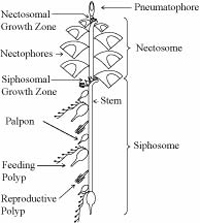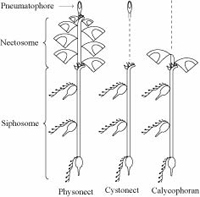
Schematic of a physonect siphonophore.

A schematic comparison of the three types of siphonophores. The dashed
lines are place holders for structures that are not present. Physonects have
a pneumatophore, nectosome, and siphosome. Cystonects have a pneumatophore
and siphosome. Calycophorans have a nectosome and siphosome.
There are three historically recognized groups of siphonophores: the cystonects, physonects, and calycophorans. It is easiest to get a grasp on siphonophores by first taking a look at physonects and then looking at how the other two groups differ from them.
All of the zooids of a physonect colony are arranged on a long stem. This stem has a gas filled float known as a pneumatophore at one end. Just behind the pneumatophore are the nectophores. These are powerful medusae specialized for moving the colony through the water. They contract in coordination, propelling the entire colony forward, backwards, and in turns. The region of the colony containing the nectophores is called the nectosome.
Just behind the nectosome is the siphosome, which has all of the remaining zooids of the colony. These include feeding polyps that each capture food with their single long tentacle, nourishing the entire colony. Reproductive structures are also found in the siphosome. The eggs and sperm of siphonophores all mature in specialized reproductive medusae. These medusae can be retained within the colony for their whole life, freed into the water, or grown on specialized polyps or groups of polyps. Some siphonophore species have male and female structures in the same colony, while the colonies of other species are exclusively male or female. A variety of other zooids are also present in the siphosome. Palpons, another type of polyp, are thought to play an excretory and defensive role, though this has never been shown for certain. Bracts, which are so modified that it is not known whether they are polyps or medusae, are structures that in many species grow so large that the other zooids can pull between them when the colony is startled. The different types of zooids in the siphosome are arranged in a species specific, repeating pattern along the stem. Each iteration of this pattern is known as a cormidium.
Cystonects differ from physonects in that they have no nectosome. They do have a pneumatophore and siphosome, though. Calycophorans differ from physonects in that they don’t have a pneumatophore, only a nectosome and siphosome. There are a few cases in the cystonects and physonects where the long stem has been reduced to a bulbous structure.

